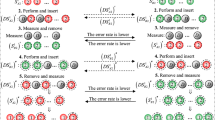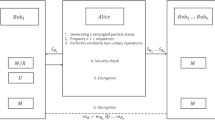Abstract
Recently, some quantum blind signature protocols have been proposed. However, the previous schemes cannot satisfy the unlinkability requirement. To overcome the drawback of unlinkability in the previous schemes, we propose a new quantum blind signature based on Bell states with the help of an authentic party. In this paper, we provide a method to inject a randomizing factor into a message when it is signed by the signer and then get rid of the blind factor from the blinded signature when it is verified by the verifier. Even when the message owner publishes the message–signature pair, the signer cannot identify the association between the message–signature pair and the blind signature he generated. Therefore, our scheme really realizes unlinkability property. At last, analysis results show that this scheme satisfies the basis security requirements of a weak signature such as no-counterfeiting, no-disavowing, blindness and traceability, and our total efficiency is not less than the previous schemes.

Similar content being viewed by others
References
Chaum, D.: Blind signature for untraceable payments. In: Proceeding of CRYPTO’82, pp. 199–203. (1983)
Harn, L.: Cryptanalysis of the blind signature based on the discrete logarithm problem. Electron. Lett. 31(14), 1136–1137 (1995)
Wen, X., Niu, X., Ji, L., Tian, Y.: A weak blind signature scheme based on quantum cryptography. Opt. Commun. 282(4), 666–669 (2009)
Wang, T.Y., Wen, Q.Y.: Fair quantum blind signatures. Chin. Phys. B 19(6), 0307 (2010)
He, L.B., Huang, L.S., Yang, W., Xu, R.: Cryptanalysis of fair quantum blind signatures. Chin. Phys. B 21(3), 030306 (2012)
Zou, X.F., Qiu, D.W.: Attack and improvements of fair quantum blind signature schemes. Quantum Inf. Process. 12, 2071–2085 (2013). doi:10.1007/s11128-012-0509-1
Su, Q., Zheng, H., Qiaoyan, W., Wenmin, L.: Quantum blind signature based on two-state vector formalism. Opt. Commun. 283(21), 4408–4410 (2010)
Yang, C.W., Hwang, T., Luo, Y.P.: Enhancement on “quantum blind signature based on two-state vector formalism”. Quantum Inf. Process. 12, 109–117 (2012). doi:10.1007/s11128-012-0362-2
Zhang, M., Xu, G.A., Xiu, B.C., Yang, S., Yang, Y.X.: Attack on the improved quantum blind signature protocol. Int. J. Theor. Phys. doi:10.1007/s10773-012-1339-8 (2012)
Yin, X., Ma, W., Liu, W.: A blind quantum signature scheme with \(\chi \)-type entangled states. Int. J. Theor. Phys. 51, 455–461 (2012)
Wang, M.M., Chen, X.B., Yang, Y.X.: A blind quantum signature protocol using the GHZ states. Sci. China Phys. Mech. Astron. 56(9), 1636–1641 (2013). doi:10.1007/s11433-013-5170-x
Wang, M.M., Chen, X.B., Niu, X.X., Yang, Y.X.: Re-examining the security of blind quantum signature protocols. Phys. Scr. 86, 055006 (2012). (6pp)
Zuo, H.J.: Cryptanalysis of quantum blind signature scheme. Int. J. Theor. Phys. doi:10.1007/s10773-012-1337-x (2012)
Khodambashi, S., Zakerolhosseini, A.: A sessional blind signature based on quantum cryptography. Quantum Inf. Process. doi:10.1007/s11128-013-0529-5 (2013)
Chaum, D.: Blind signature for untraceable payments. In Advances in Cryptology, Crypto’82, pp. 199–203. (1983)
Bennett, C., et al.: Teleporting an unknown quantum state via dual classical and Einstein-Podolsky-Rosen channels. Phys. Rev. Lett. 70, 1895–1899 (1993)
Bennett, C.H., Brassard, G.: Quantum cryptography: public key distribution and coin tossing. In: Proceedings of IEEE International Conference on Computers Systems and Signal Processing, Bangalore, India. New York: IEEE, pp. 175–179 (1984)
Long, G.L., Liu, X.S.: Theoretically efficient high-capacity quantum-key distribution scheme. Phys. Rev. A 65, 032302 (2002)
Boykin, P., Roychowdhury, V.: Optimal encryption of quantum bits. Phys. Rev. A 67, 042317 (2003)
Zhou, N., Liu, Y., Zeng, G., Xiong, J., Zhu, F.: Novel qubit block encryption algorithm with hybrid keys. Phys. A 375, 693–698 (2007)
Cabello, A.: Quantum key distribution in the Holevo limit. Phys. Rev. Lett. 85, 5635–5638 (2000)
Acknowledgments
This work is supported by the Scientific Research Common Program of Beijing Municipal Commission of Education (Grant Nos. KM201510005016); the Importation and Development of High-Caliber Talents Project of Beijing Municipal Institutions (No. CIT&TCD201304039); National Cipher Development Fund during the 12th Five-Year Plan Period (No. MMJJ201401006); Basic Research Fund of Beijing University of Technology (No. X4007999201501)
Author information
Authors and Affiliations
Corresponding author
Rights and permissions
About this article
Cite this article
Shi, WM., Zhang, JB., Zhou, YH. et al. A new quantum blind signature with unlinkability. Quantum Inf Process 14, 3019–3030 (2015). https://doi.org/10.1007/s11128-015-1036-7
Received:
Accepted:
Published:
Issue Date:
DOI: https://doi.org/10.1007/s11128-015-1036-7




